Long Span Steel Roof Trusses: A Structural Marvel in Modern Architecture
Long span steel roof trusses have become an essential component of modern architectural design, thanks to their ability to create large, open spaces without the need for intermediate support. These trusses are engineered to span significant distances while maintaining structural integrity, making them ideal for use in a wide range of buildings, from sports arenas and convention centers to aircraft hangars and warehouses.
Steel is the material of choice for long span roof trusses due to its strength, durability, and flexibility. It is also highly resistant to fire, pests, and moisture, making it an excellent option for use in areas with extreme weather conditions. In addition, steel is incredibly versatile, and it can be customized to suit the specific needs of each project, from the size and shape of the trusses to the type of connections used to join them.
One of the most significant advantages of long span steel roof trusses is their ability to create vast, unobstructed spaces, allowing architects and designers to create unique and awe-inspiring structures. For example, the Beijing National Stadium, also known as the Bird's Nest, features a stunning lattice-like steel roof made up of over 24,000 steel trusses. The roof spans an incredible 258 meters and weighs over 42,000 tons. The stadium is an excellent example of how steel trusses can be used to create iconic and visually striking buildings.
Another benefit of long span steel roof trusses is their efficiency in construction. Steel trusses are typically fabricated offsite and delivered to the construction site ready for installation. This process reduces the amount of time and labor required for on-site assembly, minimizing disruption to the surrounding environment and reducing costs. The speed and ease of construction make steel trusses a popular choice for projects with tight schedules or limited budgets.
Steel roof trusses are also incredibly durable and require minimal maintenance, making them a cost-effective choice for building owners. Steel is resistant to rust and corrosion, and it does not warp or rot like wood. Additionally, steel trusses are often coated with protective coatings that further increase their resistance to the elements. This durability means that long span steel roof trusses can last for decades or even centuries, providing reliable structural support for the building they are used in.
While steel trusses have many advantages, there are also some limitations to their use. The primary concern is their weight, as steel trusses can be incredibly heavy, especially for longer spans. This weight requires careful consideration during the design and construction phases, as the building's foundation and support structure must be able to handle the load. Additionally, steel trusses require specialized equipment and expertise for installation, which can increase costs and limit their use in certain environments.
In conclusion, Steel Truss Stadiums are a structural marvel in modern architecture, providing the strength, durability, and flexibility needed to create vast, unobstructed spaces. Steel trusses are an ideal choice for buildings with unique design requirements, tight schedules, or limited budgets, and they can last for decades with minimal maintenance. While there are some limitations to their use, the benefits of long span steel roof trusses make them a popular choice for architects, designers, and builders alike.more information


评论
发表评论